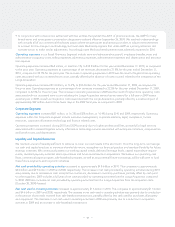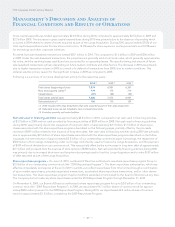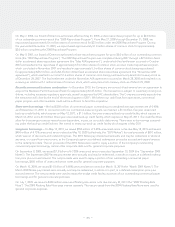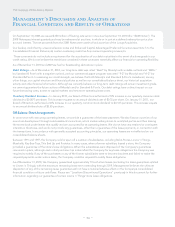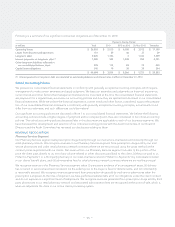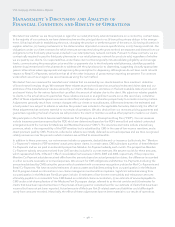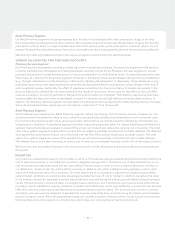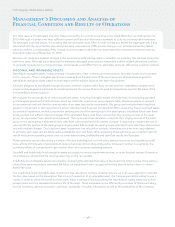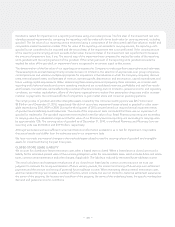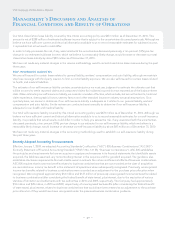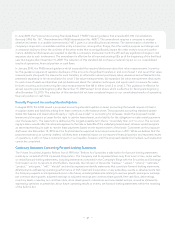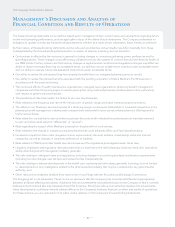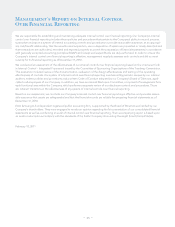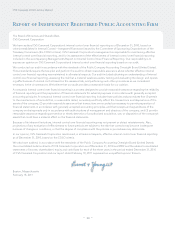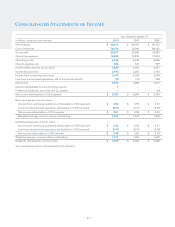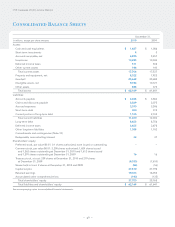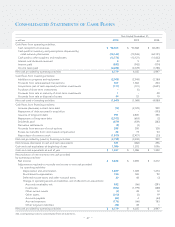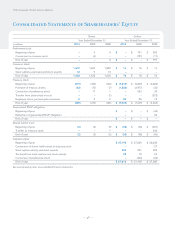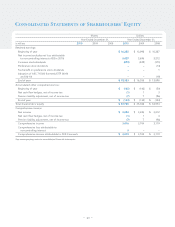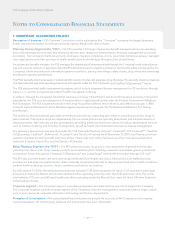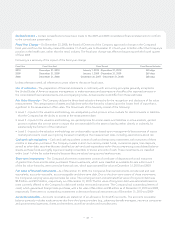CVS 2010 Annual Report Download - page 45
Download and view the complete annual report
Please find page 45 of the 2010 CVS annual report below. You can navigate through the pages in the report by either clicking on the pages listed below, or by using the keyword search tool below to find specific information within the annual report.
In June 2009, the Financial Accounting Standards Board (“FASB”) issued guidance that amends ASC 810 Consolidations
(formerly SFAS No. 167, “Amendments to FASB Interpretation No. 46(R)”). The amendment requires a company to analyze
whether its interest in a variable interest entity (“VIE”) gives it a controlling financial interest. The determination of whether a
company is required to consolidate another entity is based on, among other things, the other entity’s purpose and design and
a company’s ability to direct the activities of the other entity that most significantly impact the other entity’s economic perfor-
mance. Additional disclosures are required to identify a company’s involvement with the VIE and any significant changes in risk
exposure due to such involvement. The amendment is effective for all new and existing VIEs as of the beginning of the first fiscal
year that begins after November 15, 2009. The adoption of this standard did not have a material impact on our consolidated
results of operations, financial position or cash flows.
In January 2010, the FASB issued guidance which expanded the required disclosures about fair value measurements. In particu-
lar, this guidance requires (i) separate disclosure of the amounts of significant transfers in and out of Level 1 and Level 2 fair value
measurements along with the reasons for such transfers, (ii) information about purchases, sales, issuances and settlements to be
presented separately in the reconciliation for Level 3 fair value measurements, (iii) expanded fair value measurement disclosures
for each class of assets and liabilities and (iv) disclosures about the valuation techniques and inputs used to measure fair value
for both recurring and nonrecurring fair value measurements that fall in either Level 2 or Level 3. This guidance is effective for
annual reporting periods beginning after December 15, 2009 except for (ii) above which is effective for fiscal years beginning
after December 15, 2010. The adoption of this standard did not have a material impact on our consolidated results of operations,
financial position or cash flows.
Recently Proposed Accounting Standard Update
In August 2010, the FASB issued a proposed accounting standard update on lease accounting that would require entities to
recognize assets and liabilities arising from lease contracts on the balance sheet. The proposed accounting standard update
states that lessees and lessors should apply a “right-of-use model” in accounting for all leases. Under the proposed model,
lessees would recognize an asset for the right to use the leased asset, and a liability for the obligation to make rental payments
over the lease term. The lease term is defined as the longest possible term that is “more likely than not” to occur. The account-
ing by a lessor would reflect its retained exposure to the risks or benefits of the underlying leased asset. A lessor would recognize
an asset representing its right to receive lease payments based on the expected term of the lease. Comments on this exposure
draft were due December 15, 2010 and the final standard is expected to be issued sometime in 2011. While we believe that the
proposed standard, as currently drafted, will likely have a material impact on our reported financial position and reported results
of operations, it will not have a material impact on our liquidity; however, until the proposed standard is finalized, such evaluation
cannot be completed.
Cautionary Statement Concerning Forward-Looking Statements
The Private Securities Litigation Reform Act of 1995 (the “Reform Act”) provides a safe harbor for forward-looking statements
made by or on behalf of CVS Caremark Corporation. The Company and its representatives may, from time to time, make written
or verbal forward-looking statements, including statements contained in the Company’s filings with the Securities and Exchange
Commission and in its reports to stockholders. Generally, the inclusion of the words “believe,” “expect,” “intend,” “estimate,”
“project,” “anticipate,” “will,” “should” and similar expressions identify statements that constitute forward-looking statements.
All statements addressing operating performance of CVS Caremark Corporation or any subsidiary, events or developments that
the Company expects or anticipates will occur in the future, including statements relating to revenue growth, earnings or earnings
per common share growth, adjusted earnings or adjusted earnings per common share growth, free cash flow, debt ratings,
inventory levels, inventory turn and loss rates, store development, relocations and new market entries, as well as statements
expressing optimism or pessimism about future operating results or events, are forward-looking statements within the meaning
of the Reform Act.
– 41 –


